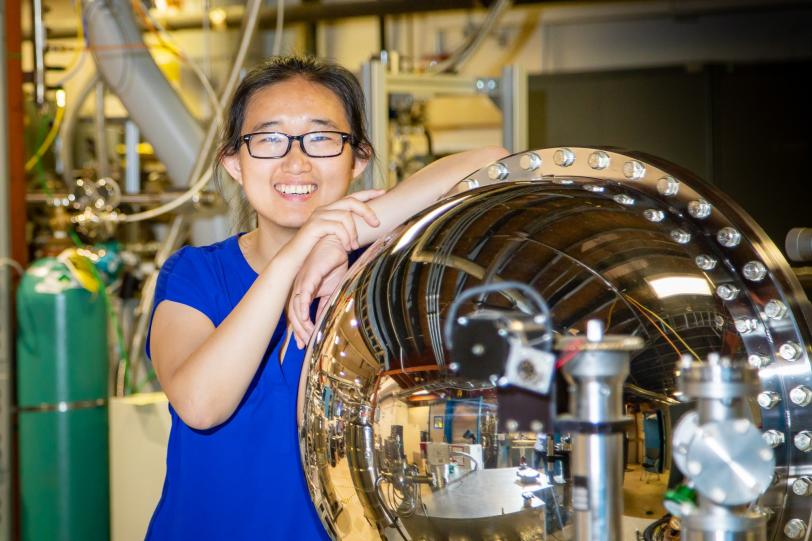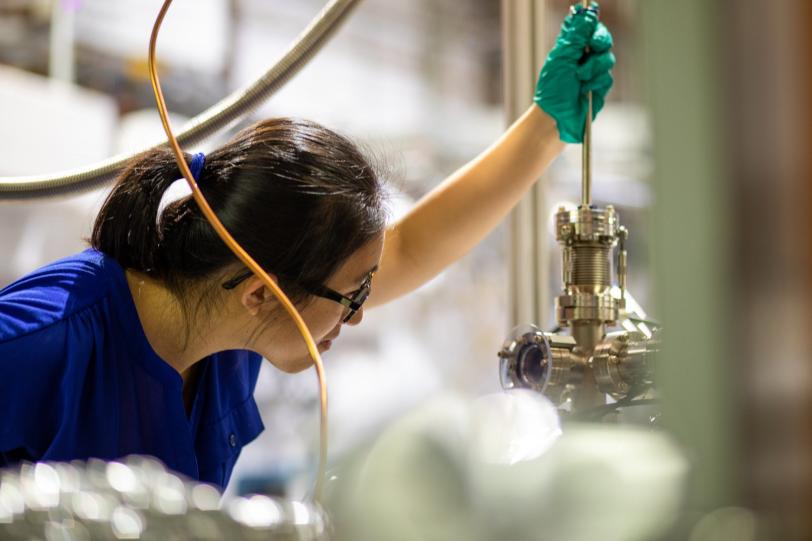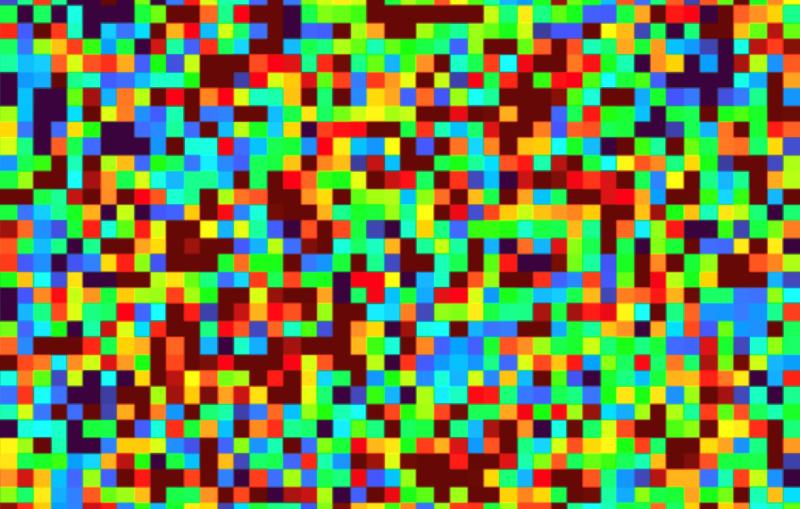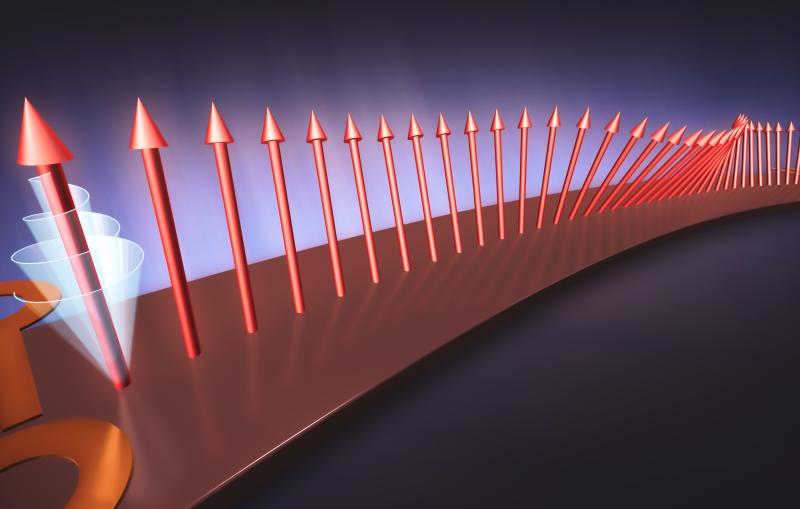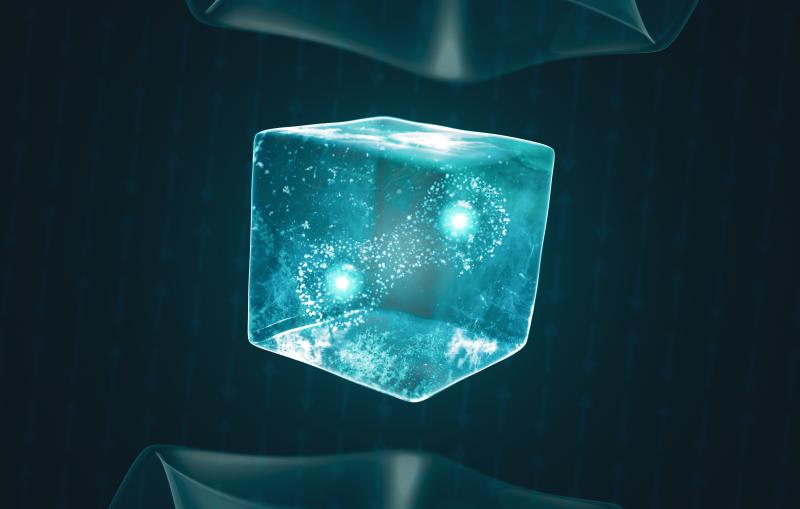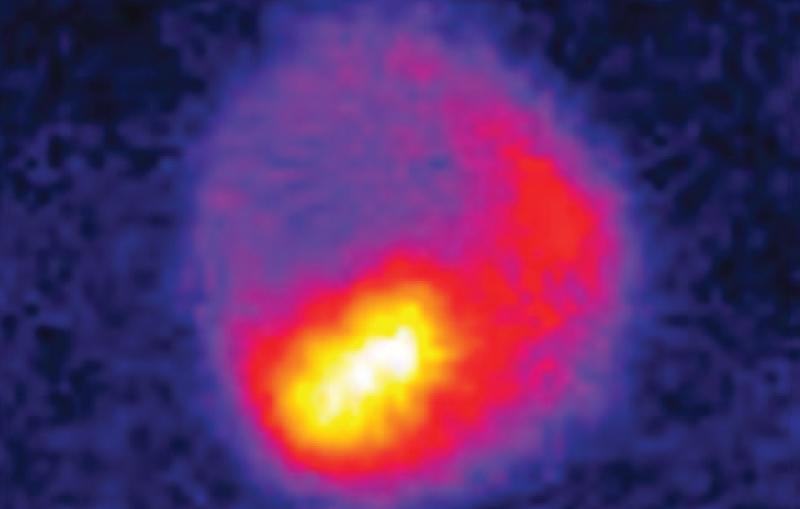Ming Yi wins Spicer Award for superconductor research at SLAC’s X-ray synchrotron
Former Stanford and UC-Berkeley physicist is honored for foundational research that peers into unconventional phenomena within exotic materials.
By Miyuki Dougherty
Ming Yi, assistant professor of physics and astronomy at Rice University, has spent the last decade unraveling the fundamental secrets of high-temperature superconductivity – a phenomenon that could transform society by allowing materials to transmit electricity without loss at close to room temperature, but whose origin remains one of the greatest unexplained mysteries in science.
In recognition of her foundational superconductor research, Yi has been awarded the 2018 William E. and Diane M. Spicer Young Investigator Award, which is presented to a young scientist who has made significant contributions to the Stanford Synchrotron Radiation Lightsource (SSRL) and the light source community. SSRL is a DOE Office of Science user facility at SLAC National Accelerator Laboratory.
During her graduate and postdoctoral studies at Stanford and the University of California, Berkeley, Yi conducted numerous experiments at SSRL that contributed to fundamental understanding of the electronic structure of iron-based superconductors, an important class of these materials. She is the lead author of 10 scholarly papers and co-author of almost 50 publications to date.
“Although still early in her professional career, Ming has already shown clear signs of promise as a researcher,” wrote her former adviser, SLAC/Stanford Professor Zhi-Xun Shen, in a nomination letter. Noting her numerous scientific publications, he added, “Ming has shown an outstanding track record and extraordinary potential.”
Yi joined Shen’s research group in the Stanford Institute for Materials and Energy Sciences (SIMES) as a graduate student in 2008.
She says the award is of special significance to her because she thinks of Bill Spicer as her academic grandfather. A Stanford professor of 40 years and researcher in electrical engineering, applied physics and materials science, Spicer co-founded the Stanford Synchrotron Radiation Project in 1972, which became SSRL. Spicer actively mentored students until his death in 2004, including Shen.
“This is a very humbling honor for my scientific endeavors as I continue my academic career, and I deeply appreciate SSRL’s commitment to nurturing young researchers in the frontiers of scientific exploration,” Yi says. “I am very grateful to all the mentors who have given me advice, support and encouragement, and who have inspired me and still inspire me every day.”
Dancing to the music of physics
As an undergraduate student at the Massachusetts Institute of Technology, Yi spent two summers as an intern at SLAC as part of the Science and Undergraduate Laboratory Internship Program (SULI), where her enthusiasm for physics quickly drew her to the field of condensed matter physics.
“SLAC has always held a special place in my heart because it was my very first window into the striking way that an international scientific community comes together to probe the unsolved mysteries of the universe,” says Yi. “Perhaps that is what ultimately drew me to the field of condensed matter physics – I am always in awe of the deep degree of emergent self-organized cooperation and competition, whether it be among the scientists doing the research or the tiny electrons that dance to the music of physics.”
During her graduate and postdoctoral research at SSRL, Yi used X-rays to probe the behavior of electrons within iron-based superconductors and unravel the necessary ingredients for high-temperature superconductivity.
Superconductors are compounds that conduct electricity with zero resistance and 100 percent efficiency. Superconducting electromagnets make some of our most powerful technologies possible; they are widely used in magnetic resonance imaging (MRI) machines and for accelerating subatomic particles in the Large Hadron Collider at CERN in Europe, currently the world’s largest and most powerful particle accelerator.
However, these superconductors have limited uses because they must be kept at very low temperatures – close to absolute zero – using expensive liquid helium. The 1986 discovery of copper-oxide superconductors was an exciting opportunity to expand applications to higher temperatures.
Despite tremendous theoretical and experimental efforts, discovering the mechanism of high-temperature superconductivity – how zillions of tiny electrons dance in synchrony with one another – has remained one of the greatest challenges in condensed matter physics.
“Understanding these electronic dances may unfold the fundamental secrets of how these exotic material properties came to be, and grant insights into how to optimize these properties for future applications,” says Yi.
Solving a three-decade quantum mystery
In 2008, a wave of excitement struck scientists all over the world when researchers discovered the newest class of high-temperature superconductors, iron-based materials.
“For many of us in this field, this discovery was a major shock since it violated an understanding of high-temperature superconductivity that many of us had built up over the previous 20 years,” says Robert J. Birgeneau, chancellor emeritus and professor of physics at UC-Berkeley and Yi’s mentor there. He adds that many research groups reacted by drastically reorienting their research efforts towards iron-based superconductors.
Physicists at the time were eager to identify commonalities between iron-based superconductors and the previously discovered class of copper-oxide high-temperature superconductors, and they also wanted to test the consistency of a ubiquitous theory of high-temperature superconductivity.
At first glance, there were key differences in the mechanisms by which copper and iron materials superconduct.
“We identified a few new electronic phases in these materials. In essence, we took a peek at the electronic dance routines within these interesting materials and found new patterns in their choreography that may hold clues to how superconductivity emerges,” explains Yi. “Synchrotron radiation not only lets us see these electrons, but also how they like to dance.”
She has also provided “compelling microscopic information” about how superconductivity competes with other phases of matter within a material, Shen wrote in his recommendation letter:“Ming’s work represents the best and most sophisticated data for this effect and will likely be a classic example for this realm of physics.”
With more time and research, the understanding of the two materials evolved. “We found similarities between these two families that indicated that there can be recurring themes among materials that may otherwise seem different at first sight,” Yi explains. “It is these common threads that may eventually lead us to a universal understanding of the phenomenon of high-temperature superconductivity.”
As a young scientist, Yi received the National Science Foundation Graduate Research Fellowship in 2008, and was awarded the L’Oréal Fellowship for Women in Science in 2015.
In addition to her scientific achievements, Yi is an active volunteer in STEM education activities such as the Berkeley Lab Adventure Zone in Elementary Sciences, and is the founder and organizer of the Moms in STEM group at UC-Berkeley.
Yi will soon start a new position at Rice University, and says she plans to return to SSRL to do further experimental studies of quantum materials.
The Spicer award will be presented to Yi during the 2018 SSRL/LCLS Annual Users’ Meeting and Workshops at SLAC on Sept. 26.
For questions or comments, contact the SLAC Office of Communications at communications@slac.stanford.edu.
SLAC is a multi-program laboratory exploring frontier questions in photon science, astrophysics, particle physics and accelerator research. Located in Menlo Park, Calif., SLAC is operated by Stanford University for the U.S. Department of Energy's Office of Science.
SLAC National Accelerator Laboratory is supported by the Office of Science of the U.S. Department of Energy. The Office of Science is the single largest supporter of basic research in the physical sciences in the United States, and is working to address some of the most pressing challenges of our time. For more information, please visit science.energy.gov.
